Carl August Buchholz
Carl August Buchholz (13 August 1796 – 7 August 1884) was a German organ builder.
Life
Born in Berlin, Buchholz learned the organ builder's trade from his father Johann Simon Buchholz. He built his own first new organ in 1817 for the Prenzlau Sabinenkirche. From 1821 onwards, he was in charge of building organs with his father. The workshop was located in Kleine Hamburger Straße/corner of Auguststraße in Berlin-Mitte. His father gave him the opportunity to try out technical innovations in organ building.
Buchholz had been married to Christiane Wilhelmine Kunsemüller, the daughter of a doctor from Wittstock, since 9 September 1820. His son Carl Friedrich Buchholz (7 July 1821 in Berlin – 17 February 1885 idem) first learned from his father and worked as a journeyman for Aristide Cavaillé-Coll in Paris around 1847/48. From 1848, he worked again for his father.
Buchholz was appointed "Academic Artist" in 1853 by the Academy of Arts (or the Prussian government ?).
After his death in 1884, his son Carl Friedrich Buchholz continued to run the workshop for a short time and died himself about six months later.
Organ building
Buchholz built exclusively mechanical organs with slider chests. Characteristic of his construction method were wedge-shaped cut sliders, which were pressed into wedge-shaped slider bands. This made it possible to compensate for changes in the wood caused by climatic conditions, for example in humid regions. Buchholz also introduced barque valves and swells as an innovation. The action was made with waveboards, modelled on those of Joachim Wagner and Ernst Julius Marx. Some of the smaller organs were built with side-playing wave frames.
Buchholz usually had architects such as Karl Friedrich Schinkel design the fronts for larger organs. For smaller instruments, he designed the models himself. The facade design shows an astonishing variety. Buchholz collaborated with organists such as August Wilhelm Bach and Carl August Haupt in the design of the stoplist. In some of the larger organs, there are striking similarities between the dispositions in the main and Oberwerk and Joachim Wagner's organ in Berlin's Marienkirche, which Buchholz had restored in 1829.[1]
Buchhol is considered the most important organ builder in the Mark Brandenburg in his time. His method of construction was characterised by the highest precision in craftsmanship. Buchholz was very modest and largely refrained from excessive self-promotion.
Students
Buchholz influenced a number of young organ builders who went on to work independently in various regions.
- Carl Friedrich Buchholz, his son
- Moritz Baumgarten, afterwards organ builder in Zahna
- Wilhelm Bergen, afterwards organ builder in Halberstadt
- Ferdinand Dinse, afterwards organ builder in Berlin
- Friedrich Friese III, afterwards important organ builder in Schwerin, Mecklenburg
- Barnim Grüneberg, his nephew, afterwards important organ builder in Stettin, Pomerania
- Ernst Hildebrand
- Johannes Kewitsch, from Berlin
- Friedrich Kienscherf, afterwards organ builder in Eberswalde
- Wilhelm Lang, afterwards organ builder in Berlin
- Ferdinand Lange, afterwards instrument maker in Berlin
- Friedrich Hermann Lütkemüller, afterwards important organ builder in Wittstock, Prignitz
- Wilhelm Meywald, afterwards organ builder in Transylvania
- Johann Rohn, afterwards organ builder in Wormditt, East Prussia
- Carl Schneider, afterwards organ builder in Kronstadt, Transylvania
- Christian Friedrich Voelkner, afterwards organ builder in Dünnow, Hinterpommern
Work
Buchholz built a total of 140 new organs between 1817 and his death in 1884. In addition, there were 20 rebuilds and restorations. All of Buchholz's organs have purely mechanical slider chests with the wedge loops he invented.
Among Buchholz's most important works is the organ built in 1839 in the Transylvanian Kronstadt in the Protestant Biserica Neagră: with 63 stops on four manuals, the Buchholz Organ of the Black Church is the largest instrument built by Buchholz and still survives today.
In 1821, he still completed the organ in the Barther Marienkirche together with his father. This organ was almost revolutionary for its time, with a 42-voice disposition distributed over two manuals and pedal and a manual range up to the three-stroke G. It is today the Buchholz organ. Today it is the Buchholz organ with the largest original inventory in Germany. The early romantic organ is of European significance.[2]
The largest Buchholz organ in Germany is in the Nikolaikirche (see Organ of the St. Nikolaikirche) and dates from 1841.
List of realisations
New buildings
The size of the instruments is indicated in the fifth column by the number of manuals and the number of sounding stops in the sixth column. A capital "P" stands for an independent pedal, a small "p" for an attached pedal. The last column contains information on the original and present condition. Italicisation indicates that the organ in question is no longer preserved or that only the casing is preserved.
With Johann Simon Buchholz
Buchholz built the organs listed below between 1812 and 1825 together with his father Johann Simon.
| Year | Location | Building | Picture | Manual | Casing | Notes |
|---|---|---|---|---|---|---|
| 1812 | Altentreptow | St. Petri | II/P | 23 | Parts and stops integrated into an organ built in 1865 by Barnim Grüneberg, restored in 2002/2003 by the organ building and restoration workshop Scheffler; today II/P/31[3] | |
| 1817 | Berlin | Oberpfarr- und Domkirche | II/P | 32 | Extension by Gebr. Dinse (Berlin) in 1886, dismantled in 1893; cathedral replaced by new building with new organ in 1905 | |
| 1817 | Neulietzegöricke | Ev. Kirche | I | 2 | Not preserved | |
| 1817 | Neu Hardenberg | Ev. Kirche | II/P | 21 | The housing designed by Schinkel in 1817 has been preserved, with a new building by W. Sauer in 1924. (Opus 1284). | |
| 1818 | Demmin | St. Bartholomaei | II/P | 40 | Restored in 1999/2000 by the organ building and restoration workshop Scheffler (Sieversdorf) → Organ of St Bartholomaei Church | |
| 1819 | Ahrensfelde | Ev. Kirche | I | 5 | Not preserved | |
| 1820 | Baruth/Mark | Stadtpfarrkirche St. Sebastian | II/P | 21 | Not preserved | |
| 1820 | Britz bei Eberswalde | Ev. Dorfkirche | I/P | 7 | Preserved | |
| 1820 | Gristow | Kirche Gristow | I/P | 13 | Extended in the 19th century by Barnim Grüneberg; preserved | |
| 1821 | Berlin-Schöneberg | Dorfkirche Schöneberg | I/P | 11 | The instrument was destroyed on 26 February 1945 when the church burned down. | |
| 1821 | Barth | St. Marien | II/P | 42 | Restored by the Orgelwerkstatt Wegscheider (Dresden) → Orgel der Marienkirche | |
| 1821 | Greifswald | St. Jakobi | II/P | 28 | Instrument destroyed in a tower fire in 1955 | |
| 1822 | Wachow | Ev. Kirche | I/P | 14 | In 1911, repair and alteration of the disposition by A. Schuke, original substance largely preserved. | |
| 1822 | Berlin | Royal Music Institute of Berlin | II/P | 13 | Built in 1888 | |
| 1823 | Böhmisch-Rixdorf | Bethlehemskirche | 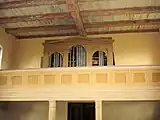 |
I/P | 13 | In the Dorfkirche Alt Gaarz since 1895 |
| 1823 | Seelübbe | Ev. Kirche | II/P | Replaced in the 2nd half of the 19th century by a work by Albert Kienscherf (Eberswalde) | ||
| 1823 | Teltow | St. Andreas | I/P | 17 | Destroyed | |
| 1824 | Stargard | St. Marien | III/P | 32 | Not preserved | |
| 1825 | Osterburg | St. Nikolai | II/P | 22 | Several times converted.[4] |
Own new buildings
From 1817 to 1847 he built alone the following organs.
| Year | Location | Building | Picture | Manual | Casing | Notes |
|---|---|---|---|---|---|---|
| 1817 | Prenzlau | Sabinenkirche | First independent organ building by C. A. Buchholz in his father's workshop; destroyed | |||
| 1824 | Görzke | Ev. Kirche | I/P | 14 | Expansion with a second manual by Friedrich Lobbes in 1882; preserved | |
| 1826 | Berlin-Britz | Dorfkirche Britz | I/P | 9 | Replaced in 1888 by a new building by Gebr. Dinse/Berlin (II+P/10), in which parts (wooden pipes) from 1826 are preserved. → Orgel | |
| 1826 | Rolofshagen | Ev. Dorfkirche | I/P | 7 | Extended in the 19th century by Mehmel; destroyed: in 1986 the village church collapsed due to lack of roof renovation. | |
| 1827 | Berlin-Kaulsdorf | Jesus Church | I/P | Replaced in 1912 by a new building by Gebr. Dinse (Berlin) | ||
| 1829 | Pütte | Ev. Dorfkirche | II/P | 14 | Restored in 2014 by the Historical Keyboard Instruments Schmidt company (Rostock) | |
| 1829 | Stralsund | Heilgeistkirche | II/P | 17 | Extension reconstruction by Alexander Schuke Potsdam Orgelbau in 1969; Front and 8 stops preserved | |
| 1830 | Grimmen | St. Marien | 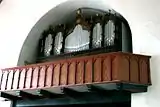 |
II/P | 26 | New construction by Mitteldeutscher Orgelbau A. Voigt in 1992; casing preserved |
| 1830 | Merz | Ev. Kirche | I | 5 | Extension around 1875 by Wilhelm Remler; preserved | |
| 1829–1831 | Berlin-Mitte | Friedrichswerdersche Kirche | III/P | 33 | New construction by Gebr. Dinse (Berlin) in 1891using old pipes and the casing, destroyed in 1944/1945 | |
| 1831 | Gützkow | St. Nikolai | II/P | 14 | Extended by W. Sauer (Frankfurt/Oder) | |
| 1831 | Tribsees | St.-Thomas-Kirche | II/P | 24 | Restoration in 1996 by Orgelbau- und Restaurierungswerkstatt Rainer Wolter | |
| 1832 | Greifswald | Dom St. Nikolai | III/P | 44 | Rebuilt in 1988 by Jehmlich Orgelbau Dresden → Orgel | |
| 1832 | Lassan | St. Johannis | 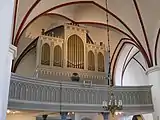 |
II/P | 17 | General overhaul in 1986 by Organ Building and Restoration Workshop Rainer Wolter (Dresden) |
| 1833 | Falkenrehde | Ev. Kirche | I | 5 | New building in 1911 by Alexander Schuke | |
| 1833 | Soest | Reformed Brunsteinkapelle | II/P | 10 | Transferred to Alt-St. Thomä in 1873, replaced there in 1913 | |
| 1834 | Berlin-Mitte | St. Elisabeth | II/P | 18 | Destroyed in 1945 | |
| 1834 | Berlin-Mitte | Heilig-Geist-Kapelle | I/P | 10 | Dismantling in 1906, whereabouts unknown | |
| 1834 | Berlin-Moabit | St. Johannis | II/P | 11 | Not preserved | |
| 1834 | Berlin-Wedding | Nazarethkirche | II/P | 11 | Replaced with new building by Walcker in 1896 | |
| 1834 | Berlin-Gesundbrunnen | St. Paul | II/P | 11 | Replaced by new building by Walcker in 1906 | |
| 1834 | Frankfurt (Oder) | St. Marien | III/P | 54 | Art treasures were removed during the Second World War; organ destroyed | |
| 1835 | Liebenwalde | Ev. Kirche | II/P | 20 | Replaced by new building by Hollenbach in 1898 | |
| 1836 | Altfriedland | Klosterkirche Altfriedland | I | Damaged in 1945, replaced in 1954 | ||
| 1836 | Elsey | Ev. Collegiate Church Elsey Abbey | Organ renovations 1953/1969/1994; not preserved | |||
| 1836 | Garz/Rügen | St. Petri | II/P | 12 | Reconstruction in 1914 by Barnim Grüneberg; Restoration in 1995 by Orgelbau- und Restaurierungswerkstatt Rainer Wolter. | |
| 1851 | Neukünkendorf, Uckermark | Village church | I/P | 7 | Attribution; later extended to I/P/8, preserved[5] | |
| 1851 | Berlin-Moabit | Gefängniskirche | Preserved ??? | |||
| 1854 | Falkenthal | Ev. Dorfkirche | I/P | 8 | Preserved[6] | |
| 1853 | Leppin, Mecklenburg | Village church | I/P | 9 | Preserved[7] | |
| 1854 | Friedersdorf near Seelow | Ev. Dorfkirche | I/P | 9 | Replaced in 1999.[8] | |
| 1854 | Berlin-Mitte | Reformierte Synagoge Johannisstraße | II/P | 18 | Replaced in 1912[9] | |
| 1855 | Berlin-Friedrichshain | St. Markus | II/P | 30 | Probably not preserved | |
| 1855 | Templin, Uckermark | St. Maria und Magdalenen | II/P | 37 | Casing by Gottlieb Scholtze from 1769, replaced in 1921 by Jehmlich with some pipes, baroque casings preserved[10] | |
| 1856 | Berlin-Friedrichshain | St. Andreas | II/P | 27 | Probably destroyed | |
| 1856 | Brodowin, Uckermark | Village church | 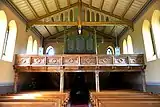 |
I/P | 9 | Preserved.[11] |
| 1856 | Hennigsdorf near Berlin | Martin-Luther-Kirche | II/P | Not preserved | ||
| 1856 | Schwedt/Oder, Uckermark | St. Katharinen | I/P | Not preserved | ||
| 1856 | Stüdenitz | Dorfkirche | I/P | 10 | Largely preserved.[12] | |
| 1856 | Berlin-Prenzlauer Berg | Elisabethstift Kapelle | I/P | 7 | Builder unknown, assumption Buchholz, Lange or Dinse.[13] | |
| 1857 | Berlin-Kreuzberg | Realschule | II/P | 9 | Probably not preserved | |
| 1857 | Königsberg | St. Johannis | Destroyed in 1945 | |||
| 1857 | Memel, Ostpreußen | St. Johannis | III/P | 42 | Not preserved | |
| 1858 | Berlin-Friedrichshain | St. Bartholomäus | II/P | 17 | Not preserved | |
| 1858 | Berlin-Rosenthal | Ev. Dorfkirche | I/P | 9 | ||
| 11 | Preserved ?[14] | |||||
| 1862 | Berlin-Mitte | Königliche Oper | Not preserved |
As Carl August Buchholz & Sohn
From around 1866, the company operated under the name Carl August Buchholz & Sohn.
| Year | Location | Building | Picture | Manual | Casing | Notes |
|---|---|---|---|---|---|---|
| 1866 | Berlin-Mitte | New Synagogue | III/P | 45 | Destroyed in 1945 at the latest | |
| 1867 | Grieben | Evangelische Kirche | II/P | 9 | ||
| 1867 | Lanke | Evangelische Kirche | I/P | 9 | ||
| 1868 | Flatow | Evangelische Kirche | II/P | 12 | ||
| 1868 | Neu Boltenhagen | St. Marien | II/P | 8 | ||
| 1869 | Diedersdorf | Evangelische Kirche | I/P | 7 | ||
| 1869 | Düpow | Evangelische Kirche | I/P | 9 | [15] | |
| 1869 | Melkof | Gutskirche Melkof | 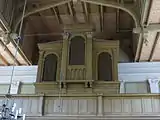 |
II/P | 10 | Restored in 2018 by the Plauer organ builder Andreas Arnold.[16] |
| 1869 | Potsdam | St. Peter and Paul | II/P | 25 | Reconstruction in 1936 (including electrification) and addition of a third manual by Karl and Hans-Joachim Schuke (Potsdam), using Buchholz pipe material (11 stops complete and 10 stops partially preserved). →Orgel | |
| 1870 | Netzelkow | Evangelische Kirche | ||||
| 1872 | Klein Oschersleben | Ev.-luth. Kirche | 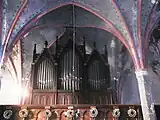 |
II/P | 14 | |
| 1876 | Gutengermendorf | Evangelische Kirche | ||||
| 1878 | Potsdam | Bethlehemkirche | ||||
| 1882 | Hall of the Reichshallentheater | Berlin-Mitte | II/P | 18 | Erected in 1893 in St. Matthias, Berlin, replaced in 1914. | |
| 1884 | Nossendorf | Ev.-luth. St. Marien | ||||
| 1884 | Alt Gaarz | Ev. Kirche Rerik | I/P | 13 | ||
| 1884 | Ribbeck | Evangelische Kirche | I/P | 22 | ||
| ? | Brandenburg an der Havel | St. Johannis (Brandenburg an der Havel) | II/P | 18 |
Conversions and repairs
| Year | Location | Building | Picture | Manual | Casing | Notes |
|---|---|---|---|---|---|---|
| 1826 | Bad Wilsnack | St. Nikolai | ||||
| 1828 | Stralsund | St. Marien | → Stellwagen-Orgel | |||
| 1829 | Berlin-Mitte | St. Mary's Church, Berlin | ||||
| 1833 | Berlin | Dorotheenstädtische Kirche | ||||
| 1833 | Berlin-Mitte | Friedrichswerdersche Kirche | ||||
| 1837 | Zachow | Village church | (orgellandschaftbrandenburg.de) | I/P | 11 | Instrument by Joachim Wagner[17] |
| 1840 | Osterburg | Martinskapelle | ||||
| 1845 | Angermünde | St. Marien | ||||
| 1851 | Berlin-Mitte | Parochialkirche | With his son | |||
| 1851 | Berlin-Kreuzberg | Jerusalemskirche | ||||
| 1851 | Berlin-Spandau | St. Nikolai | With his son | |||
| 1851 | Boitzenburg | St. Marien auf dem Berge | With his son | |||
| 1857 | Nauen | St. Jacobi |  |
With his son | ||
| 1861 | Halberstadt | Halberstadt Cathedral | With his son: Orgel des Domes zu Halberstadt | |||
| 1864 | Brandenburg an der Havel | St. Katharinen | With his son | |||
| 1865 | Brandenburg an der Havel | St. Gotthardt | With his son | |||
| 1877 | Berlin-Mitte | Sophienkirche | With his son |
References
- Carl August Buchholz Black Church of Kronstadt (Memento)
- orgel-information.de: "Die Orgel in St. Marien zu Barth", retrieved 17 February 2021.
- Matthias Gretzschel: "Orgeln in Mecklenburg-Vorpommern. Für die Zeit gerettet." In Hamburger Abendblatt. Axel Springer AG, Hamburg 2003, ISBN 3-921305-26-8.
- Orgel in Osterburg, retrieved 17 February 2021.
- Hannes Ludwig: Orgelhandbuch Brandenburg. Part 2. Uckermark (eastern part). Freimut & Selbst, Berlin 2008, p. 206.
- Orgel in Falkenthal Orgeldatabase
- Orgel in Leppin Orgelmuseum Malchow
- Geschichte der Orgel in Friedersdorf Institut für Orgelforschung Brandenburg
- Information Orgeldatabase
- Today's organ in Templin Organ database, with Buchholz disposition. (niederländisch)
- Orgel in Brodowin Institut für Orgelforschung Brandenburg
- Orgel in Stüdenitz Orgeldatabase
- Information Orgeldatabase
- Information Orgeldatabase
- Orgel Dorf Düpow
- "Das Schweigen beendet". svz.de. 7 December 2018. Retrieved 17 February 2021.
- Karl Richter: Zachow (Czachów). In Schinkel und ein Rätseltext oder: Zachow gibt uns noch zu denken. 20 March 2007, p. 2. Online (PDF, 1,5 MB) auf der Website Orgellandschaft Brandenburg, retrieved 17 February 2021.
Further reading
- Carl August Buchholz †. 1884. p. 226.
{{cite book}}:|work=ignored (help) - Wolf Bergelt, ed. (1996). "Dein tief betrübter Papa". Ein Beitrag zur Buchholz-Forschung. Berlin: Freimut & Selbst.
- Franz Gerhard Bullmann (1980). Hardenberg, Zelter und Orgelbauer Buchholz. pp. 99–102.
{{cite book}}:|work=ignored (help) - Susi Jeans (1987). The Organ Builders J. S. and C. A. Buchholz of Berlin. pp. 207–210.
{{cite book}}:|work=ignored (help) - Salomon Kümmerle (1888). Buchholz, Firma. pp. 196 f.
{{cite book}}:|work=ignored (help) - Hans-Dieter Meyer (2004). Buchholz und Haupt, oder: Wie der Barkerhebel nach Deutschland kam. pp. 75–80.
{{cite book}}:|work=ignored (help) - Uwe Pape (2000). Buchholz, Familie. pp. 1179–1183.
{{cite book}}:|work=ignored (help) - Uwe Pape, Wolfram Hackel, Christhard Kirchner (ed.): Lexikon norddeutscher Orgelbauer. Vol. 4. Berlin, Brandenburg und Umgebung einschließlich Mecklenburg-Vorpommern. Pape Verlag, Berlin 2017, ISBN 978-3-921140-06-2, pp. 77–79.
- Dietrich W. Prost (1988). Das Wirken der Berliner Orgelbauer Buchholz in Vorpommern. pp. 149–160.
{{cite book}}:|work=ignored (help)
External links
- Literature by and about Carl August Buchholz in the German National Library catalogue
- Literature about Carl August Buchholz in the State Bibliography (Landesbibliographie) of Mecklenburg-Vorpommern